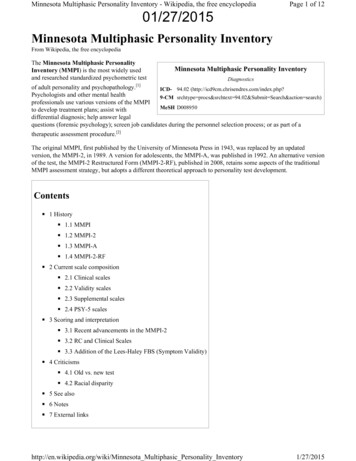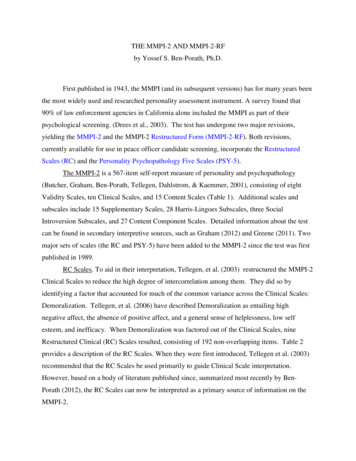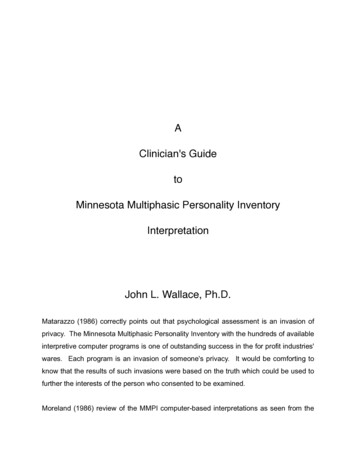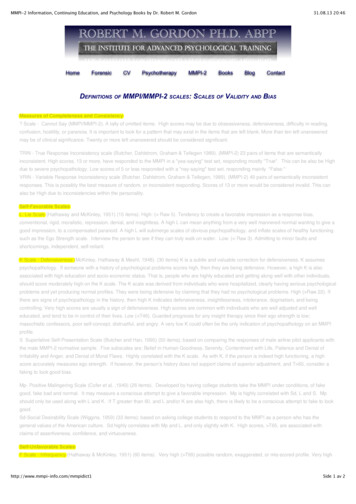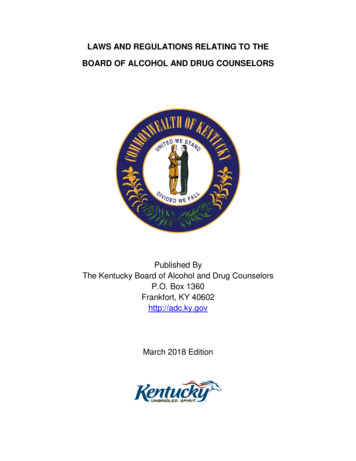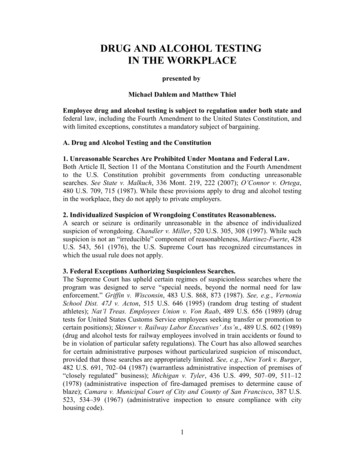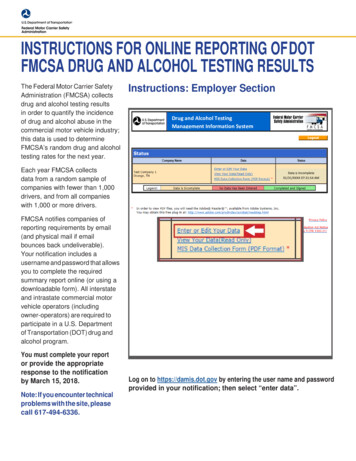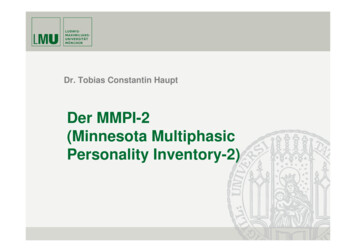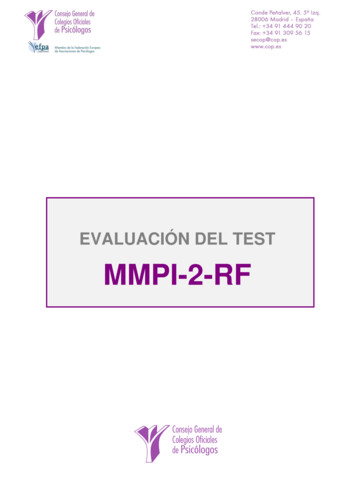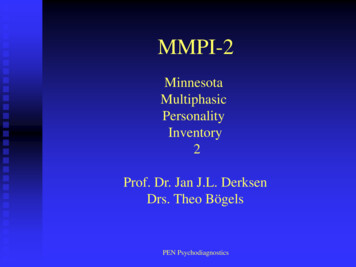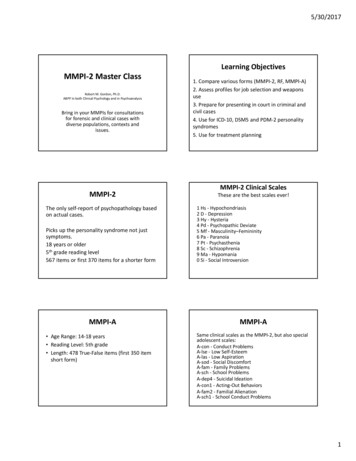
Transcription
SAMPLE REPORTCase Description: Grace — Drug/Alcohol TreatmentInterpretive ReportGrace, a 16-year-old African American, was being evaluated in an alcohol and drug treatment centerfollowing a drinking incident and an automobile accident. Her 18-year-old boyfriend was driving the car.The investigating officer found an open liquor bottle and a small amount of marijuana in the car, andarrested both of them at the scene.Grace lives with her maternal grandmother. Her parents are divorced and her mother lives and works inanother state. Grace visits her mother during the summer and at Christmas. For the rest of the year, theironly contact is occasional phone calls. Grace’s father left the family when she was five months old. Overthe course of the last year, she has had increasing difficulties with her grandmother. Three weeks prior tothe current incident, Grace did not come home for three days and did not let her grandmother know whereshe was. When she returned home and her grandmother confronted her about her behavior, Grace left inanger for two more days. Her grandmother reported that Grace is very sullen and argumentative at home.Increasing difficulties in school over the past year were also reported during the initial session with Grace.She was under disciplinary suspension for fighting with a classmate in the lunchroom just before thedrinking incident. Although her academic performance was strong during middle school, her performancein high school has been marginal. She has had a number of unexcused absences, and she is failing many ofher classes.The Minnesota Report was included during Grace’s initial evaluation in the alcohol and drug treatmentcenter, revealing considerable psychological distress and acting out problems from all three profiles (i.e.,Clinical and Supplementary Scales, Content Scales, and PSY-5 Scales). Problems with anger control,aggressive behaviors, and possible violence are especially prominent in the narrative given the elevationson the Anger Content Scale and the Aggressiveness PSY-5 Scale. Her life at home and in school is full ofconflicts. Although placed in an alcohol/drug treatment center, Grace did not acknowledge problems inCase descriptions do not accompany MMPI-A reports, but are provided here as background information. The followingreport was generated from Q-global , Pearson’s web-based scoring and reporting application, using Grace’s responses tothe MMPI-A. Additional MMPI-A sample reports, product offerings, training opportunities, and resources can be foundat PearsonClinical.com/mmpia.Copyright 2014 Pearson Education, Inc. or its affiliate(s). All rights reserved. Q-global, Always Learning, Pearson, design for Psi, and PsychCorp are atrademarks, in the U.S. and/or other countries, of Pearson Education, Inc. or its affiliate(s).Minnesota Multiphasic Personality Inventory-A and MMPI-A are registered trademarks of the University of Minnesota, Minneapolis, MN. 8795-A 01/14
SAMPLE REPORTCase Description (continued): Grace — Drug/Alcohol TreatmentInterpretive Reportthis area, given her score on ACK, and that she only endorsed one of the nine substance abuse item levelindicators (see p. 15 of her Report). However, her score was highly elevated on the Alcohol/Drug ProblemProneness Scale, and the narrative indicates that substance abuse is a strong likelihood.Grace’s Minnesota Report also indicates several internalizing problems found in her somewhat mixedsymptom pattern. Interestingly, given the prominence of her acting out problems, and high score onProneness, suggesting negative peer group influences as part of her issues with alcohol and drugs, sheappeared shy, possibly socially withdrawn and anxious. In addition to information in the narrativesections about tension, worries, and sleep, the clinician can use the Harris-Lingoes Subscales and ContentComponent Scales (pp. 10–11) to refine the interpretation of Grace’s MMPI-A. Of note are the indicatorsof feelings of depression, somatic complaints, alienation and social isolation, in addition to her problems ofimpulse control, anger, and authority problems.
Drug/Alcohol Treatment Interpretive ReportGrace SampleCase666616Female1/27/14SAName:ID Number:Age:Gender:Date Assessed:MPLEMMPI -AThe Minnesota Report : Adolescent Interpretive System, 2nd EditionJames N. Butcher, PhD, & Carolyn L. Williams, PhDCopyright 1992, 2007 by the Regents of the University of Minnesota. All rights reserved. Portions reproduced from the MMPI-A test booklet.Copyright 1942, 1943, (renewed 1970), 1992 by the Regents of the University of Minnesota. All rights reserved. Portions excerpted from theMMPI-A Manual for Administration, Scoring, and Interpretation. Copyright 1992 by the Regents of the University of Minnesota. All rightsreserved. Portions excerpted from the Supplement to the MMPI-A Manual for Administration, Scoring, and Interpretation: The ContentComponent Scales, The Personality Psychopathology Five (PSY-5) Scales, The Critical Items. Copyright 2006 by the Regents of theUniversity of Minnesota. All rights reserved. Distributed exclusively under license from the University of Minnesota by NCS Pearson, Inc.MMPI and Minnesota Multiphasic Personality Inventory are registered trademarks and MMPI-A, Minnesota Multiphasic PersonalityInventory-Adolescent, and The Minnesota Report are trademarks of the University of Minnesota. Pearson, the PSI logo, and PsychCorpare trademarks in the U.S. and/or other countries of Pearson Education, Inc., or its affiliate(s).TRADE SECRET INFORMATIONNot for release under HIPAA or other data disclosure laws that exempt trade secrets from disclosure.[ 4.4 / 1 / QG ]
ID: 6666Grace SampleCaseMMPI -A Drug/Alcohol Treatment Interpretive Report1/27/14, Page 2MMPI-A VALIDITY SCALES PROFILE110110100100908080E907060504030Raw Score:T Score:TRINSAVRINMPLFResponse %:Cannot Say 01001001001001000Percent True:49Percent False:51
ID: 6666Grace SampleCaseMMPI -A Drug/Alcohol Treatment Interpretive Report1/27/14, Page 3MMPI-A CLINICAL AND SUPPLEMENTARY SCALES cMaSiRaw Score:1835343426172938283819T Score:6877747956595965646448Welsh Code:100 100100 100 100 100 100 100 100 100423'18 90-675/ F/K:L#Mean Profile Elevation:68.160504030HsResponse %:70MPL70MAC-R ACKPROIMMAR4272327165175686358100 100 100 100 100 100
ID: 6666Grace SampleCaseMMPI -A Drug/Alcohol Treatment Interpretive Report1/27/14, Page 4MMPI-A CONTENT SCALES 030A-anx A-obs A-dep A-hea A-aln A-biz A-ang A-cyn A-con A-lse A-las A-sod A-fam A-sch A-trtRaw Score:T Score:Response 6166847960100 100 100 100 100 100 100 100 100 100 100 100 100 100 100
ID: 6666Grace SampleCaseMMPI -A Drug/Alcohol Treatment Interpretive Report1/27/14, Page 5MMPI-A PSY-5 SCALES 04030AGGRPSYC30DISCNEGEINTRRaw Score:155111716T Score:7150596575100100100100100Response %:80
ID: 6666Grace SampleCaseMMPI -A Drug/Alcohol Treatment Interpretive Report1/27/14, Page 6VALIDITY CONSIDERATIONSThis is a valid MMPI-A. The individual was cooperative in describing her symptoms and problems. Hergenerally frank and open responses to the items can be viewed as a positive indication of herinvolvement with the evaluation. The MMPI-A profiles are probably a good indication of her presentpersonality functioning and symptoms.SYMPTOMATIC BEHAVIOREThis adolescent's MMPI-A clinical profile reflects a high degree of psychological distress at this time.An intense and somewhat mixed pattern of symptoms is indicated. She appears rather tense anddepressed and may be feeling agitated over problems in her environment. She may be experiencing agreat deal of stress following a period of acting-out behavior, possibly including problem use of alcoholor other drugs.MPLShe appears to be developing a pattern of poor impulse control and a lack of acceptance of societalstandards of behavior. This individual may also be angry about her present situation and may blameothers for her problems. She may be seeking a temporary respite from situational stress. She mayattempt to manipulate others through her symptoms in order to escape responsibility for the problemsshe has created.SAHer two-point MMPI-A clinical profile configuration includes high points D and Pd. This is the mostfrequently occurring two-point scale pair for adolescent girls in alcohol/drug or mental health treatmentunits. Over 15% of girls in treatment programs have this clinical profile. It should be noted that thishigh-point code occurs somewhat less frequently among girls in the normative population (about 4%)and at a lower level of elevation than in clinical samples.In a large archival sample of MMPI-A cases scored by Pearson Assessments (n 12,744), thishigh-point pair of scale elevations (Pd and D) was found for 3.3% of the girls, using well-defined peakscores of 65 or above, and more than 5 points separation from the third highest scale.Extreme responding is apparent on her MMPI-A Content Scales profile. She endorsed at least 90% ofthe items on A-ang in the deviant direction, indicating that the following is quite important inunderstanding her problem situation. Assaultive or very aggressive acting-out behavior is likely becauseshe reports considerable problems in controlling her anger. She may be unusually interested in violenceand aggression.In addition to the extreme endorsements found in her MMPI-A Content Scales profile, she alsodescribed other important problem areas. This young person reports numerous difficulties in school. Sheprobably has poor academic performance and does not participate in school activities. She may have ahistory of truancy or suspensions from school. She probably has very negative attitudes about school,possibly reporting that the only positive aspect of school is being with her friends. She may have someanxiety or fears about going to school.
ID: 6666Grace SampleCaseMMPI -A Drug/Alcohol Treatment Interpretive Report1/27/14, Page 7She reported several symptoms of anxiety, including tension, worries, and difficulties sleeping. Sheendorsed several very negative attitudes about herself and her abilities.An examination of the adolescent's underlying personality factors with the PSY-5 scales might helpexplain any behavioral problems she might be presently experiencing. She shows a meager capacity toexperience pleasure in life. Persons with high scores on the Introversion/Low Positive Emotionalityscale tend to be pessimistic, anhedonic (unable to experience pleasure), and socially withdrawn with fewor no friends. She is likely viewed as being aggressive toward others given her high Aggressivenessscale score. This aggression may be manifest through her using intimidating tactics or physicalaggression in order to accomplish her immediate goals. Elevated Aggressiveness scores also suggest thepossibility of sexual acting out.EINTERPERSONAL RELATIONSMPLHer relationships may be somewhat superficial. She may use others for her own gratification. She issomewhat hedonistic and may act out impulsively without due concern for the feelings of friends orrelatives. She has probably been experiencing strained interpersonal relationships.She is somewhat shy, with some social anxiety and inhibitions. She is a bit hypersensitive about whatothers think of her and is occasionally concerned about her relationships with others. She appears to besomewhat inhibited in personal relationships and social situations, and she may have some difficultyexpressing her feelings toward others. She may try to avoid crowds, parties, or school activities.SASome problems with her relationships are evident from her extreme endorsement of items on A-ang.She reports considerable problems controlling her anger, and she may swear or yell when she becomesannoyed. Temper tantrums, irritability, and impatience probably interfere with her relationships. Heranger may result in aggressive actions directed at others or their property.In addition to her extreme endorsements on the MMPI-A Content Scales, she reported other significantinterpersonal issues. Family problems are quite significant in this person's life. She reports numerousproblems with her parents and other family members. She describes her family in terms of discord,jealousy, fault finding, anger, serious disagreements, lack of love and understanding, and very limitedcommunication. She looks forward to the day when she can leave home for good, and she does not feelthat she can count on her family in times of trouble. Her parents and she often disagree about herfriends. She indicates that her parents treat her like a child and frequently punish her without cause. Herfamily problems probably have a negative effect on her behavior in school. She reports many problemsin social relationships. She finds it difficult to be around others and much prefers to be alone. She mayfeel distant from others, believing that they do not understand or care about her. She may feel that shehas no one to rely on.
ID: 6666Grace SampleCaseMMPI -A Drug/Alcohol Treatment Interpretive Report1/27/14, Page 8BEHAVIORAL STABILITYThe relative scale elevation of her highest clinical scales (D, Pd) suggests clear profile definition. Hermost elevated clinical scales are likely to be present in her profile pattern if she is retested at a later date.This clinical profile reflects some maladaptive characteristics that could develop into personalityproblems. Although she appears to be experiencing much acute distress, her personality problems maycontinue even after current stresses subside and she feels more comfortable.DIAGNOSTIC CONSIDERATIONSEAn adolescent with this clinical profile may receive a diagnosis of oppositional or conduct disorder withsome depressive features.MPLGiven her elevation on the School Problems scale, her diagnostic evaluation could include assessmentof possible academic skills deficits and behavior problems. Her endorsement of several anxiety-basedsymptoms should be considered in her diagnostic work-up.TREATMENT CONSIDERATIONSSAAlthough individuals with this clinical profile usually express a great need for help, they tend not to begood candidates for traditional psychotherapy. They may resist behavior change and tend to terminatetreatment early when their situational stress is reduced.Some individuals with this MMPI-A pattern attempt to manipulate others through suicidal gestureswhen their needs are not being met.Because substance abuse is a strong possibility among individuals with this clinical profile, any use ofmedications should be cautiously monitored.Her very high potential for developing alcohol or drug problems requires attention in therapy ifimportant life changes are to be made. However, her relatively low awareness of or reluctance toacknowledge problems in this area might impede treatment efforts.She should be evaluated for the presence of suicidal thoughts and any possible suicidal behaviors. If sheis at risk, appropriate precautions should be taken.Her family situation, which is full of conflict, should be considered in her treatment planning. Familytherapy may be helpful if her parents or guardians are willing and able to work on conflict resolution.However, if family therapy is not feasible, it may be profitable during the course of her treatment toexplore her considerable anger at and disappointment in her family. Alternate sources of emotionalsupport from adults (e.g., foster parent, teacher, other relative, friend's parent, or neighbor) could beexplored and facilitated in the absence of caring parents.
ID: 6666Grace SampleCaseMMPI -A Drug/Alcohol Treatment Interpretive Report1/27/14, Page 9There are some symptom areas suggested by the Content Scales profile that the therapist may wish toconsider in initial treatment sessions. Her endorsement of several anxiety-based symptoms could beexplored further.Conditions in her environment that may be contributing to her aggressive and assaultive behaviorscould be explored. Adolescents with anger-control problems may benefit from modeling approaches andrewards for appropriate behaviors. Stress-inoculation training or other cognitive-behavioral interventionscould be used to teach self-control. Observations of her behavior around her peers may provideopportunities to intervene and prevent aggressive actions toward others.SAMPLEShe endorsed some items that indicate possible difficulties in establishing a therapeutic relationship.She may be reluctant to self-disclose, she may be distrustful of helping professionals and others, and shemay believe that her problems cannot be solved. She may be unwilling to assume responsibility forbehavior change or to plan for her future.
ID: 6666Grace SampleCaseMMPI -A Drug/Alcohol Treatment Interpretive Report1/27/14, Page 10ADDITIONAL SCALESA subscale or content component scale should be interpreted only when its corresponding parent scalehas an elevated T score of 60 or above. Subscales and content component scales printed below in boldmeet that criterion for interpretation.Raw ScoreT ScoreResp 00100100100100Psychopathic Deviate SubscalesFamilial Discord (Pd1)Authority Problems (Pd2)Social Imperturbability (Pd3)Social Alienation (Pd4)Self-Alienation (Pd5)853797165495767100100100100100Paranoia SubscalesPersecutory Ideas (Pa1)Poignancy (Pa2)Naivete 0100100100183739545064100100100100Depression SubscalesSubjective Depression (D1)Psychomotor Retardation (D2)Physical Malfunctioning (D3)Mental Dullness (D4)Brooding (D5)SAMPLHysteria SubscalesDenial of Social Anxiety (Hy1)Need for Affection (Hy2)Lassitude-Malaise (Hy3)Somatic Complaints (Hy4)Inhibition of Aggression (Hy5)EHarris-Lingoes SubscalesSchizophrenia SubscalesSocial Alienation (Sc1)Emotional Alienation (Sc2)Lack of Ego Mastery, Cognitive (Sc3)Lack of Ego Mastery, Conative (Sc4)Lack of Ego Mastery, Defective Inhibition (Sc5)Bizarre Sensory Experiences (Sc6)Hypomania SubscalesAmorality (Ma1)Psychomotor Acceleration (Ma2)Imperturbability (Ma3)Ego Inflation (Ma4)
ID: 6666Grace SampleCaseMMPI -A Drug/Alcohol Treatment Interpretive Report1/27/14, Page 11Raw ScoreT ScoreResp %7413526163100100100Adolescent DepressionDysphoria (A-dep1)Self-Depreciation (A-dep2)Lack of Drive (A-dep3)Suicidal Ideation (A-dep4)236050557142100100100100Adolescent Health ConcernsGastrointestinal Complaints (A-hea1)Neurological Symptoms (A-hea2)General Health Concerns (A-hea3)073445756100100100Social Introversion SubscalesShyness / Self-Consciousness (Si1)Social Avoidance (Si2)Alienation--Self and Others (Si3)MPLEContent Component Scales531696348100100100Adolescent Bizarre MentationPsychotic Symptomatology (A-biz1)Paranoid Ideation (A-biz2)405643100100Adolescent AngerExplosive Behavior (A-ang1)Irritability (A-ang2)787366100100Adolescent CynicismMisanthropic Beliefs (A-cyn1)Interpersonal Suspiciousness (A-cyn2)835143100100Adolescent Conduct ProblemsActing-Out Behaviors (A-con1)Antisocial Attitudes (A-con2)Negative Peer Group Influences (A-con3)730694942100100100Adolescent Low Self-EsteemSelf-Doubt (A-lse1)Interpersonal Submissiveness (A-lse2)836659100100Adolescent Low AspirationsLow Achievement Orientation (A-las1)Lack of Initiative (A-las2)545860100100SAAdolescent AlienationMisunderstood (A-aln1)Social Isolation (A-aln2)Interpersonal Skepticism (A-aln3)
ID: 6666Grace SampleCaseMMPI -A Drug/Alcohol Treatment Interpretive Report1/27/14, Page 12T ScoreResp %8668581001001877374100100Adolescent School ProblemsSchool Conduct Problems (A-sch1)Negative Attitudes (A-sch2)266570100100Adolescent Negative Treatment IndicatorsLow Motivation (A-trt1)Inability to Disclose (A-trt2)646254100100Adolescent Family ProblemsFamilial Discord (A-fam1)Familial Alienation (A-fam2)ERaw ScoreAdolescent Social DiscomfortIntroversion (A-sod1)Shyness (A-sod2)SAMPLUniform T scores are used for Hs, D, Hy, Pd, Pa, Pt, Sc, Ma, the content scales, the content componentscales, and the PSY-5 scales. The remaining scales and subscales use linear T scores.
MMPI -A Drug/Alcohol Treatment Interpretive Report1/27/14, Page 13ID: 6666Grace SampleCaseITEM-LEVEL INDICATORSThe MMPI-A contains a number of items whose content may indicate the presence of psychologicalsymptoms when endorsed in the deviant direction. The MMPI-A critical item list includes 15 categoriesthat may provide an additional source of hypotheses about this young person.However, caution should be used when interpreting item-level indicators like the MMPI-A criticalitems because responses to single items are much less reliable than scores on full-length scales. Anindividual can easily mismark or misunderstand a single item, and not intend the answer given.Furthermore, many adolescents in the normative sample endorsed some of the MMPI-A critical items inthe deviant direction. For this reason, the responses to the item-level indicators printed below include theendorsement frequency for the item in the normative sample to give the clinician an indication of howcommon or rare the response is in the general population.EAggression(Of the three possible items in this section, two were endorsed in the scored direction):MPL453. Item Content Omitted. (20.2% of the normative girls responded True.)465. Item Content Omitted. (26.9% of the normative girls responded False.)Anxiety(Of the six possible items in this section, four were endorsed in the scored direction):Item Content Omitted. (15.3% of the normative girls responded True.)Item Content Omitted. (23.1% of the normative girls responded True.)Item Content Omitted. (12.5% of the normative girls responded True.)Item Content Omitted. (16.3% of the normative girls responded True.)SA36.163.173.353.Conduct Problems(Of the seven possible items in this section, five were endorsed in the scored direction):249.354.440.445.460.Item Content Omitted. (29.3% of the normative girls responded False.)Item Content Omitted. (28.1% of the normative girls responded True.)Item Content Omitted. (26.2% of the normative girls responded True.)Item Content Omitted. (21.3% of the normative girls responded True.)Item Content Omitted. (25.6% of the normative girls responded False.)ITEMSNOTSHOWNSpecial Note:The content of the test itemsis included in the actual reports.To protect the integrity of the test,the item content does not appearin this sample report.
MMPI -A Drug/Alcohol Treatment Interpretive Report1/27/14, Page 14ID: 6666Grace SampleCaseDepression/Suicidal Ideation(Of the seven possible items in this section, one was endorsed in the scored direction):71. Item Content Omitted. (15.7% of the normative girls responded False.)Family Problems(Of the three possible items in this section, one was endorsed in the scored direction):365. Item Content Omitted. (28.9% of the normative girls responded False.)School Problems(Of the five possible items in this section, two were endorsed in the scored direction):MPLE101. Item Content Omitted. (24.2% of the normative girls responded True.)389. Item Content Omitted. (18.8% of the normative girls responded True.)Self-Denigration(Of the five possible items in this section, one was endorsed in the scored direction):90. Item Content Omitted. (22.7% of the normative girls responded True.)SASexual Concerns(Of the four possible items in this section, three were endorsed in the scored direction):59. Item Content Omitted. (33.9% of the normative girls responded False.)159. Item Content Omitted. (33.7% of the normative girls responded True.)251. Item Content Omitted. (38.0% of the normative girls responded True.)Somatic Complaints(Of the nine possible items in this section, three were endorsed in the scored direction):138. Item Content Omitted. (23.0% of the normative girls responded False.)165. Item Content Omitted. (25.6% of the normative girls responded True.)214. Item Content Omitted. (25.2% of the normative girls responded True.)ITEMSNOTSHOWNSpecial Note:The content of the test itemsis included in the actual reports.To protect the integrity of the test,the item content does not appearin this sample report.
MMPI -A Drug/Alcohol Treatment Interpretive Report1/27/14, Page 15ID: 6666Grace SampleCaseSubstance Use/Abuse(Of the nine possible items in this section, one was endorsed in the scored direction):161. Item Content Omitted. (29.2% of the normative girls responded True.)Unusual Thinking(Of the four possible items in this section, two were endorsed in the scored direction):291. Item Content Omitted. (36.5% of the normative girls responded True.)417. Item Content Omitted. (27.5% of the normative girls responded True.)End of ReportMPLEThis young person did not endorse any items from the following MMPI-A critical items categories:Cognitive ProblemsEating ProblemsSpecial Note:ITEMSNOTHallucinatory ExperiencesThe content of the test itemsSHOWNis included in the actual reports.Paranoid IdeationTo protect the integrity of the test,the item content does not appearin this sample report.SANOTE: This MMPI-A interpretation can serve as a useful source of hypotheses about adolescent clients.This report is based on objectively derived scale indexes and scale interpretations that have beendeveloped with diverse groups of clients from adolescent treatment settings. The personalitydescriptions, inferences, and recommendations contained herein need to be verified by other sources ofclinical information because individual clients may not fully match the prototype. Only a qualified,trained professional should use the information in this report.This and previous pages of this report contain trade secrets and are not to be released in response torequests under HIPAA (or any other data disclosure law that exempts trade secret information fromrelease). Further, release in response to litigation discovery demands should be made only in accordancewith your profession's ethical guidelines and under an appropriate protective order.
frequently occurring two-point scale pair for adolescent girls in alcohol/drug or mental health treatment units. Over 15% of girls in treatment programs have this clinical profile. It should be noted that this high-point code occurs somewhat less frequently among girls in the normative population (about 4%)
